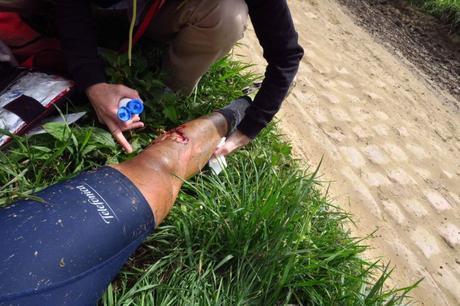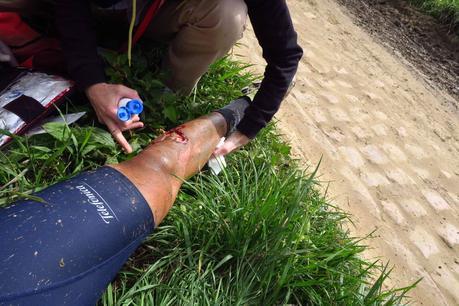

Sobre los frenos de disco.
Llevo trece años en el ciclismo profesional y otros tantos en categorías inferiores. Sí, veintiséis años sobre la bici, cada día entrenando y disfrutando de lo que más me gusta, de mi pasión. Desde los seis años he competido, lo sigo haciendo y disfruto mucho. Contento de haber hecho de mi vocación mi profesión.
Como cualquier deporte, el ciclismo ha ido evolucionando en muchos aspectos técnicos... y en otros, no tanto.
En todos estos años he visto mejoras en el material: primero, el acero; después, el aluminio; y más tarde, el carbono. Este último llegó para quedarse, gracias a sus características técnicas de rigidez y ligereza. También he visto cómo se ha pasado de los rastrales a los pedales automáticos, mucho más cómodos, efectivos y seguros. De las chichoneras hemos pasado a cascos cada vez más ligeros, con diseños espectaculares y, además, con todas las garantías de seguridad.
También he visto un avance muy importante en los desarrollos. Mi primera bici tenía un plato y tres piñones; ahora ya vamos por dos platos, incluso tres, y once piñones... y seguro que no se acaba aquí. Todo ello, con un sistema de ensayo y error, nada fácil. Me acuerdo de las primeras roturas de cadena cuando se pasó a los diez piñones: algo así como eslabones que se abrían, por materiales que no eran del todo fiables (aún ocurre). Podemos hablar también de la revolución que ha supuesto el cambio electrónico. Al principio a todos nos sorprendió y lo juzgábamos (no es necesario, puede fallar, las baterías, mi bici enchufada a la red...). Ahora, no nos imaginamos la bici sin ello.
Hace un par de años se empezaron a ver las primeras bicis con frenos de disco en ciclocross, y se rumoreaba qué cabía la posibilidad que se empezaran a probar en competiciones de Ciclismo en Carretera.
Quiero decir, antes de nada, que soy el primero en recomendar los frenos de disco, bien sea para ciclocross o para un ciclodeportista que sale con sus amigos a disfrutar de nuestro deporte.
Pero en competición profesional... ¿de verdad alguien pensaba que no iba a suceder? ¿de verdad nadie pensó que son peligrosos? ¿Que cortan, que son auténticas cuchillas gigantes?
En la pasada París-Roubaix, solo dos equipos los utilizaron. Dos equipos con ocho ciclistas respectivamente. En total, dieciséis ciclistas que trasportaban treinta y dos discos en el pelotón. Pues bien: en un tramo de pavé, en el km 130 concretamente, se produce una montonera y el correspondiente frenazo, que me hace impactar por detrás al corredor que tengo delante, que intentaba librar la caída. No llego a caer -solo mi pierna toca su parte trasera de la bici- y continúo. Al poco de reanudar la marcha, me miro la pierna: no me duele, no hay demasiada sangre, pero observo que parte del periostio está al descubierto. Veo la funda que recubre mi tibia. Me aparto a la derecha, me tiro en el césped, echo mis manos a la cara, empiezo a marearme... Espero a mi coche de equipo y a la ambulancia, mientras me pasan muchas cosas por la cabeza.
¿Mala suerte? ¿Me ha tocado a mí? No lo creo: a los pocos kilómetros se confirma lo que pienso.
Quince kilómetros más adelante entra en la ambulancia Nikolas Maes, del equipo Etixx. Tiene un tajo profundo en una de sus rodillas, producido por un disco, uno de esos treinta y dos. La pregunta es inmediata: qué sucederá cuando haya 396 discos en una carrera donde los 198 ciclistas peleamos por la posición y las caídas son inevitables?
Los discos NUNCA deberían haber llegado al pelotón profesional, al menos como los conocemos hasta este momento. Al menos hasta que cuenten con sistemas de protección y seguridad que no los conviertan en auténticos cuchillos instalados en las bicis.
Sin embargo, hay problemas para cambiar las ruedas después de un pinchazo; problemas para los coches neutros en caso de que sea un momento en que tu coche de equipo no te puede asistir... y lo más importante: son cuchillas, que a ciertas velocidades se convierten en auténticos machetes. Hay carreras en las que alcanzamos velocidades máximas de 80, 90 e incluso 100 kilómetros por hora.
Yo he tenido suerte: es solo la pierna, solo músculo y piel. ¿Os imagináis un disco en una yugular, en una femoral? No: mejor no imaginar.
Y todo esto sucede porque la Asociación de Corredores Internacional (CPA), asociaciones de corredores nacionales, federaciones nacionales e internacionales, equipos y, sobre todo, NOSOTROS, LOS CICLISTAS PROFESIONALES, no hemos hecho nada. Pero ahora toca actuar y poner sentido común a lo que es una evidencia. Siempre pensamos que mientras no nos pase a nosotros no es un problema. Esperamos a que ocurran cosas para tomar medidas. Antes o después nos puede tocar a cualquiera: son probabilidades, todos tenemos las mismas. Los profesionales debemos ver más lejos de nuestro propio ombligo, y utilizo esta expresión para que quede claro. Otros nos dicen lo que tenemos que hacer, pero no podemos olvidar que NOSOTROS DEBEMOS Y TENEMOS LA DECISIÓN DE ELEGIR.
Los discos cortan. Ha sido la mía, pero puede ser la de cualquiera.
Open letter: Fran Ventoso.
On disc brakes.
I've spent thirteen years in the pro cycling peloton and another thirteen moving up the ladder in youth categories. That makes it 26 years on my bike, training every day, enjoying what I like most, my passion. Since I was six, I've enjoyed racing, and I continue to do so. I'm so happy to have turned my vocation into a dream job.
Just like in any other sport, cycling has evolved in many technical aspects. However, it has not done so in others in a way we'd all have liked.
Through all these years, I've witnessed many improvements on different parts of the bike and cycling apparel. We started off with steel, then aluminum, and later on, carbon. That last one came here to stay, since it was as rigid as we needed while also offering lightness. We've also stopped using toeclips for clipless pedals, much more comfortable, effective and secure. Days are long gone when we used hairnet helmets: modern ones are now lighter, beautiful to the eye and offer absolute security guarantees when you use them.
I've also seen very important improvements on gearing. My first bike had one chainring and three sprockets; nowadays, we use two chainrings, even three, and 11 sprockets... and I'm certain it won't end there. Technology evolution has been a sort of trial and error: getting to this point hasn't been easy. I remember how easily chains were broken when we first used ten sprockets: links that broke, because of materials still not as resistant as it was required... it still happens today. We could also talk about the revolution that has brought the electronic shifting. When it was first shown and used, we all were surprised and made early judgments: it's not necessary, it might not work well, carrying batteries seems wrong, having to connect your bike to AC is bonkers... And now, we can't imagine our bikes without it.
My point is: two years ago, we started seeing disc brakes put on cyclocross bikes, and the rumour was that there could be a chance that they be tested in road cycling events.
Beforehand, I want to make this clear: I'm so in favor as anyone else that cyclocross professionals or participants in sportives enjoy the advantages of disc brakes during their rides.
But then, there's pro road cycling events. Was there really anyone who thought things like Sunday's wouldn't happen? Really nobody thought they were dangerous? Nobody realized they can cut, they can become giant knives?
At Paris-Roubaix, only two teams used them. With eight riders each, that makes it sixteen, carrying a total 32 disc brakes into the peloton. Let me take you to 130km into the race: into a cobbled section, a pile-up splits the field, with riders falling everywhere. I've got to break but I can't avoid crashing against the rider in front of me, who was also trying not to hit the ones ahead. I didn't actually fall down: it was only my leg touching the back of his bike. I keep riding. But shortly afterwards, I have a glance at that leg: it doesn't hurt, there's not a lot of blood covering it, but I can clearly see part of the periosteum, the membrane or surface that covers my tibia. I get off my bike, throw myself against the right-hand side of the road over the grass, cover my face with my hands in shock and disbelief, start to feel sick... I could only wait for my team car and the ambulance, while a lot of things come through my mind.
Just a stroke of bad luck? I don't thing so: few kilometers later, one of the thoughts I had sitting in the gutter becomes real.
15km after my incident, Nikolas Maes, a rider from Etixx-Quick Step, comes into the very same ambulance I'm sitting in. There's a deep wound in his knee, produced by another disc, one of those 32. One question comes inevitably and immediately to one's mind: what will happen when 396 discs get into a race where 198 riders ferociously battle for position?
Disc brakes should have NEVER arrived into the peloton, not at least as we know them right now. I haven't met any rider who has run out of braking power with traditional brakes; I haven't known anyone who didn't see his wheels skidding when you brake with all power you've got, no matter traditional or disc brakes. Then: why using them?
Conversely, there are lots of problems to change wheels after a puncture; added trouble for neutral service, which has to carry three or four different sets of wheels to help you out in case your team car is not around... and the most worrying thing, as I stated before, is that disc brakes in its actual concept are giant knives, 'machetes' when crashing against or crashed by them at a certain speed. And in some points, we reach 80, 90, 100 kilometres per hour.
I've been lucky: I didn't get my leg chopped off, it's just some muscle and skin. But can you imagine that disk cutting a jugular or a femoral vein? I would prefer not to.
All of this happens because the international riders' association -the CPA-, national riders' associations, international and national feds, teams and, above all of them, OURSELVES, PROFESSIONAL RIDERS, are not doing anything. We always think that it's not a problem if it doesn't happen to ourselves. We always wait for horrible things to happen in order to take measures. Sooner or later, it could happen to anybody: it's a matter of probability, we've all got the same. Pro riders should take a look beyond our own belly. Others tell us what we should do, but we just can't forget WE'VE GOT THE POWER TO CHOOSE, AND WE SHOULD MAKE A CHOICE.
Disks produce cuts. This time it was me; tomorrow, it can be more serious and happen to others.
Fuente: Fran Ventoso
